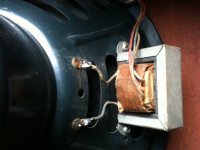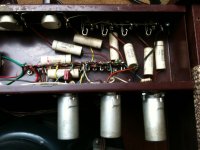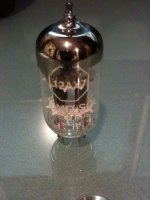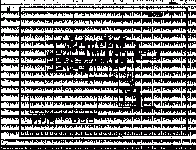I just got a new Mercury Magnetics power transformer in my '55 GA-20 as well as an overhaul with crumbling/leaking components and now I think the speaker should be replaced because I have virtually no clean headroom at all before it breaks. It's pretty cool distortion but am interested in preserving the original Jensen speaker 1) for later re-sale with the amp whenever I sell it and 2) enjoying more Fender Deluxe kind of head room with a replacement speaker this amp is supposed to deliver.
My question though is how to go about it since this speaker is nothing like speakers you buy today.
Can you tell me what the impedance of the original 22nd week/1955 speaker is? My Jensen has a choke or coil on it and none of the speakers suggested for replacing it (i.e. Jensen P12N) have that. Also, how do I replace this older speaker with a modern speaker? There are 3 cables from the chassis to the Coil/Choke and then 2 to the speaker. Would I keep the coil/choke and then take the 2 wires from it to the replacement speaker?
I appreciate any help to get this amp happening again from over 60 years ago.
My question though is how to go about it since this speaker is nothing like speakers you buy today.
Can you tell me what the impedance of the original 22nd week/1955 speaker is? My Jensen has a choke or coil on it and none of the speakers suggested for replacing it (i.e. Jensen P12N) have that. Also, how do I replace this older speaker with a modern speaker? There are 3 cables from the chassis to the Coil/Choke and then 2 to the speaker. Would I keep the coil/choke and then take the 2 wires from it to the replacement speaker?
I appreciate any help to get this amp happening again from over 60 years ago.
Attachments
Hi, I cant offer u any help in finding a replacement speaker, but I can tell u that the "choke/coil" that u refer to mounted to the speaker frame is actually the amplifier's Output transfomer, so yes, u would keep the output transformer & find a suitable replacement speaker of the required impedance. Hope this helps. Cheers
Last edited:
You can have it reconed there are a plethera of folks out there that do reconing up to and including the voice coil...just a google away
Best regards, Elwood
Best regards, Elwood
If you call up ted weber Iam sure they will provide some options. They are pretty much the experts in the us on vintage guitar replacement speaks.
You can also measure the speakers ohm with a multimeter although you will need to desolder the transformer first. It should read 6 ohm ish if its an 8 ohm speaker wich it likely is.
Or you can just replace it with a modern jensen or celestion or whatever suit you.
webervst.com redirect to tedweber.com
You can also measure the speakers ohm with a multimeter although you will need to desolder the transformer first. It should read 6 ohm ish if its an 8 ohm speaker wich it likely is.
Or you can just replace it with a modern jensen or celestion or whatever suit you.
webervst.com redirect to tedweber.com
You can have it reconed there are a plethera of folks out there that do reconing up to and including the voice coil...just a google away/QUOTE]
thanks, I'll try TedWeber since I want to leave the speaker alone and not sure that reconing it would still give me the clean headroom I'm seeking. I think it's ok for a sale at least if I wanted down the line.
I'm more curious about a new speaker with all new components that would be a good match for the Mercury PT.
Hi, I cant offer u any help in finding a replacement speaker, but I can tell u that the "choke/coil" that u refer to mounted to the speaker frame is actually the amplifier's Output transfomer, so yes, u would keep the output transformer & find a suitable replacement speaker of the required impedance. Hope this helps. Cheers
thanks ivan
wav file of the GA-20 with original Jensen speaker. Is speaker healthy?
Could someone listen and tell me if this original speaker sounds healthy? I recorded at 3 levels with a '56 Les Paul:
https://drive.google.com/file/d/0B0a8Dih66NeTUHZMRnpRR2ZlaTA/view?usp=sharing
9 o'clock
12 o'clock
3 o'clock
full o'clock 😀
I would think that a new speaker would be cleaner at least up to half way, no? appreciate the recommendation about a new speaker or not.
thanks
Could someone listen and tell me if this original speaker sounds healthy? I recorded at 3 levels with a '56 Les Paul:
https://drive.google.com/file/d/0B0a8Dih66NeTUHZMRnpRR2ZlaTA/view?usp=sharing
9 o'clock
12 o'clock
3 o'clock
full o'clock 😀
I would think that a new speaker would be cleaner at least up to half way, no? appreciate the recommendation about a new speaker or not.
thanks
YMMV, but this crunch does not sound like a broken/worn out speaker to me.
I don't know the amp in detail, but it sounds more like tube-overdrive of some sort.
In that case I doubt if a new speaker would give you more clean headroom.
My 2 C.
I don't know the amp in detail, but it sounds more like tube-overdrive of some sort.
In that case I doubt if a new speaker would give you more clean headroom.
My 2 C.
For more head room you may try changing the 6sl7 to a 6sn7 tube. it may also change the voicing of the amp but is a reversible mod
My Jensen has a choke or coil on it and none of the speakers suggested for replacing it (i.e. Jensen P12N) have that.
Isn't that just the output transformer, mounted to the speaker frame instead of chassis? Three wires to primary (plates and CT), two wires from secondary to terminals of the load. Doesn't really look like a choke or FC wiring. Just looks like an OT mounted to a different place than the chassis.
Oh, if headroom is an issue then you might want to replace that cheap little OT Gibson seemed to favour for some reason. Additionally, an amplifier with approximately 10 watts of output power (that you get from a push-pull pair of 6V6 tubes) and word "headroom" don't really fit too well into same sentence, unless you fit the word "lacking" in there too. 😉
That in mind, even swapping in a speaker with good efficiency figures won't save you from the fact that the amp has output power level of a generic practice amp (and that at moderately high figures of THD) and a pesky output transformer, which will be another source of distortion and probably lacking a lot on low end response. Oh, and Gibson tended to use somewhat thin baffle boards so you can't really reliably fit anything moderately heavy there without reinforcing the baffle somehow.
That said, several people feel that trying to overcome these issues and making the amp "better" will just rob away all its original character and tone. If the amp is "wrong" for you from the get go then you'd likely be better off with an amp that isn't. Just my two cents...
Last edited:
Did you absolutely make sure the replacement PT puts out the same voltage? Can you determine if the plate voltages are in spec? Everything is wired correctly? If somehow the B+ voltages are lower, then you will lose any clean headroom that was available. Generally, lower B+ equals more distortion.
I'm with teemuk on this one; I own a few PA amps in the 10-15 watt range that I have converted for guitar and it is pretty hard to get much clean headroom with only 10 watts.
I also think it is not the speaker. When they go south, they seem to sound different than your recorded samples. Sounds like tube overdrive/distortion.
It certainly wouldn't hurt to try a speaker rated at 30W or more to eliminate speaker breakup.
I'm with teemuk on this one; I own a few PA amps in the 10-15 watt range that I have converted for guitar and it is pretty hard to get much clean headroom with only 10 watts.
I also think it is not the speaker. When they go south, they seem to sound different than your recorded samples. Sounds like tube overdrive/distortion.
It certainly wouldn't hurt to try a speaker rated at 30W or more to eliminate speaker breakup.
Now that I have looked at the schematic, I see they used the old grid-leak bias method on the two input tubes. That is those 10 meg. resistors. Sometimes this old bias method provided too little bias voltage which would bias the tube hot. If there is much less than 1.5 or 2v then this is also a source of distortion. Once these tubes distort there is no clean signal to be had. You could look at rebuilding the input network to bias one of them toward center bias which is around 2-2.5 volts and leave the other input the way it is . This way you could use an A/B switch to go between cleaner and dirty.
It's still going to produce only about 10 - 15 watts at best. ...through a somewhat undersized OT.
There's are not the sort of amps that would excel in "headroom" department. Fix that issue and they are not that "Vintage Gibson Amp" anymore.
There's are not the sort of amps that would excel in "headroom" department. Fix that issue and they are not that "Vintage Gibson Amp" anymore.
Isn't that just the output transformer, mounted to the speaker frame instead of chassis?.
Yes indeed, someone helped point that out earlier. I'd never really seen one before so glad I posted the photo.
Oh, if headroom is an issue then you might want to replace that cheap little OT Gibson seemed to favour for some reason.
That's a very interesting idea teemuk, thanks. re: the natural tube distortion, yeah I realize its a practice amp but what's not making sense to me is that put yourself in 1956 and you just bought this amp. You plug in your 56 Strat and even its single coils break this amp up at 1/4 turn - instrument channel. You have never heard of Jeff Beck yet so you hear this tube distortion. Wouldn't you think the amp is "broken" with your 1956 ears?
Or is this what all these 10-14 watt amps sounded like at bedroom levels?
So if in fact the OT was 1) cheap and 2) tends to deteriorate after 60 years, then it would make sense to me. I bought Mercury Mag's "factory" replacement power transformer for this model of amp so I didn't get the original burned out PT re-wound. Could that also be a factor in pumping up the distortion?
Hi saxguy,what type tube is the farthest to the right as you look at the back of the amp?
Looks like the amp guy replaced whatever was in there before with a new Tung-Sol 12AX7 when he replaced the Mercury GA20-P PT and some other parts inside the amp
original speaker: 12" Jensen Gold label P12R C5920 serial 220523 (1955, 23rd week) June 5th-11th
Original amp specs:
Inputs(instr. + mic.) 3+1
Channels 2
Volume Controls 2
Tone Controls Bass, treble
No Tubes 6
Preamp. 2-6SJ7
Phase splitter 6SL7
Output 2-6V6
Rect. 5Y3
Watts Output 12-14
Cathode biased
Attachments
It looks like this amp has had some other work done. The 6SJ7 tube has an 8-pin octal socket, like the power tubes. Your 12ax7 obviously is a 9-pin miniature. Try a 12AY7. That tube has much less gain. It might change the tone but should clean up the signal some.
One more note, the 6sj7 is a pentode. If it was replaced by a 12ax7, perhaps both sections of the ax7 are being cascaded, resulting in the no clean headroom sound. I suggest you figure out how many stages there are in this amp. Based on the original spec and schematic, it shouldn't be so dirty sounding as it had a pentode gain stage, then into the 6sl7 splitter then output tubes. Better yet, post a schematic of the actual amp.
[/ATTACH]Here you go guys, schematic, pics and video.
I don't know much about that amp, but it's pretty similar to a tweed deluxe which has almost no headroom with humbuckers or p-90's. Fenders are a different story. My strat stays pretty clean up to half way up.
These little amps really aren't for clean tones. And they really aren't loud enough gigging unless mic'ed. But they sound awesome. I think the OP's amp sounds great. It's not the speaker that is causing it to break up early.
So, a speaker isn't going to help much. Something efficient, like a Alnico blue can help becasue you can get more volume and stay cleaner. I have used a greenback and a blue in my tweed deluxe (5e3) clone. I would use the blue if I wanted a cleaner sound.
Switching to a 12ay7 in V1 should be your first option. Basically, as someone said before, 2 6SJ7 were switched for a 12axy, which has 2 sections. I doubt the 12ax7 is being cascaded, it's just replacing the two 6SJ7. The 12ay7 has about 50% the gain of 12ax7.
Also, switching to a solid state rectifier can tighten things up a bit. Weber has a drop in replacement for the 5Y3:
Weber Copper Cap Rectifiers
Also, it's popular on Tweed deluxes to increase the value of the coupling caps when using humbuckers or P-90's. This helps keep the sound from "farting out".
Saxguy: I wouldn't make any changes to the amp that aren't reversible or plug in. That's a valuable piece, and you might be better off selling it and getting something different if it's not right for you. If we look at the Tweed deluxe 5e3...which your amp is real similar to, that amp is pretty closely associated with Neil Young and ZZ top. Real crunchy, raw stuff. They can play clean, just not with much volume.
Here's a good demonstration (great guitar shop too)...
https://www.youtube.com/watch?v=XCS6Ekvzwqw
BTW, you know the volume controls are interactive, right? And I believe the tone control has an effect on gain.
That's about all I got. If you don't like the amp send it to me.
I don't know much about that amp, but it's pretty similar to a tweed deluxe which has almost no headroom with humbuckers or p-90's. Fenders are a different story. My strat stays pretty clean up to half way up.
These little amps really aren't for clean tones. And they really aren't loud enough gigging unless mic'ed. But they sound awesome. I think the OP's amp sounds great. It's not the speaker that is causing it to break up early.
So, a speaker isn't going to help much. Something efficient, like a Alnico blue can help becasue you can get more volume and stay cleaner. I have used a greenback and a blue in my tweed deluxe (5e3) clone. I would use the blue if I wanted a cleaner sound.
Switching to a 12ay7 in V1 should be your first option. Basically, as someone said before, 2 6SJ7 were switched for a 12axy, which has 2 sections. I doubt the 12ax7 is being cascaded, it's just replacing the two 6SJ7. The 12ay7 has about 50% the gain of 12ax7.
Also, switching to a solid state rectifier can tighten things up a bit. Weber has a drop in replacement for the 5Y3:
Weber Copper Cap Rectifiers
Also, it's popular on Tweed deluxes to increase the value of the coupling caps when using humbuckers or P-90's. This helps keep the sound from "farting out".
Saxguy: I wouldn't make any changes to the amp that aren't reversible or plug in. That's a valuable piece, and you might be better off selling it and getting something different if it's not right for you. If we look at the Tweed deluxe 5e3...which your amp is real similar to, that amp is pretty closely associated with Neil Young and ZZ top. Real crunchy, raw stuff. They can play clean, just not with much volume.
Here's a good demonstration (great guitar shop too)...
https://www.youtube.com/watch?v=XCS6Ekvzwqw
BTW, you know the volume controls are interactive, right? And I believe the tone control has an effect on gain.
That's about all I got. If you don't like the amp send it to me.
Attachments
Last edited:
OK, I went back and looked at the pics of your gibson...
It still has 3 preamp tubes. 12x7 > 6SJ7 > 6SL7. Someone thought they were:
A) doing you a favor by replacing the V1 6SJ7 w/ a 12ax7 because the 6SJ7 is not available new, only NOS so it's hard to find.
or
B) Is cascading the 12ax7 for more gain.
Even using one side of 12ax7 you will have more gain than a 6SJ7. The 6Sj7 has a gain factor of 70. The 12ax7 has a gain factor of 100. If you replace the 12ax7 w/a 12ay7 it has a gain factor of 50 of think. So really, if you want headroom, the 12ax7 is a poor choice no matter what.
If it was me, I'd put back in a 6SJ7. Good, NOS 6SJ7 are cheap and it keeps the amp correct and probably is better for resale. New, russian or chinese 12ax7 are crap. JJ's are OK, a bit dark...Good NOS 12ax7 are priced through the roof.
If you can get a good pic at the top of the V1 (12ax7) tube socket we may be able to tell you what's up. Don't touch anything inside the amp...even unplugged it may give you a lethal shock. Use wooden chopsticks to move wires out of the way if you have to.
It still has 3 preamp tubes. 12x7 > 6SJ7 > 6SL7. Someone thought they were:
A) doing you a favor by replacing the V1 6SJ7 w/ a 12ax7 because the 6SJ7 is not available new, only NOS so it's hard to find.
or
B) Is cascading the 12ax7 for more gain.
Even using one side of 12ax7 you will have more gain than a 6SJ7. The 6Sj7 has a gain factor of 70. The 12ax7 has a gain factor of 100. If you replace the 12ax7 w/a 12ay7 it has a gain factor of 50 of think. So really, if you want headroom, the 12ax7 is a poor choice no matter what.
If it was me, I'd put back in a 6SJ7. Good, NOS 6SJ7 are cheap and it keeps the amp correct and probably is better for resale. New, russian or chinese 12ax7 are crap. JJ's are OK, a bit dark...Good NOS 12ax7 are priced through the roof.
If you can get a good pic at the top of the V1 (12ax7) tube socket we may be able to tell you what's up. Don't touch anything inside the amp...even unplugged it may give you a lethal shock. Use wooden chopsticks to move wires out of the way if you have to.
- Status
- Not open for further replies.
- Home
- Live Sound
- Instruments and Amps
- 1955 Gibson GA-20 should replace speaker; How?



